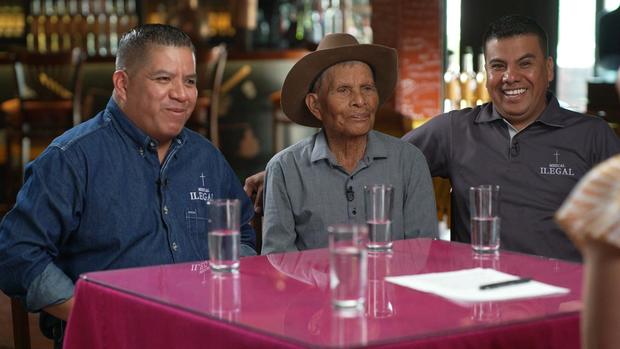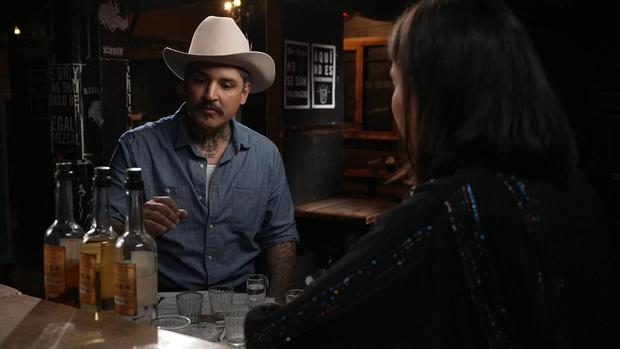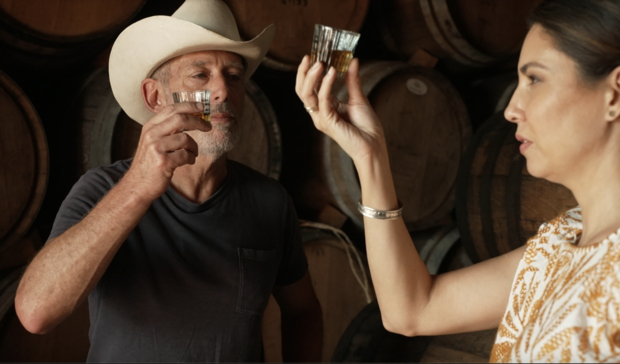This is an updated version of a story first published on Sept. 29, 2024. The original video can be viewed here.
For years, mezcal sat in the shadow of its popular cousin tequila …known for its worm…and deemed too smokey for a spot on the same shelf as premium spirits. But not anymore. Once banned and later sold in plastic jugs for pennies, the handcrafted spirit has found its way into cocktail bars and Michelin-starred restaurants. As we first told you last fall, no other liquor has seen a greater increase in production in the past decade. Mezcal gets its name from the Aztec word for cooked agave– a thorny plant sacred to Mexico for thousands of years. The vast majority of mezcal is made in the southern state of Oaxaca… where family-owned distilleries dot the landscape. We went to meet the mezcaleros as they labor to quench the world’s thirst for mezcal.
Mezcaleros harvest agave year round but it’s no low-hanging fruit. Pried from the earth, the spikes are removed by machete…revealing the heart – the piña – which looks like a hundred pound pineapple…Agave takes its sweet time to ripen, up to 30 years for some varieties. It grows in the valleys that run between the Sierra Madre mountains– Here in Oaxaca, the crossroads of indigenous and spanish colonial cultures, the birthplace of mezcal. And Santiago Matatlan is its cradle.
The Hernandez brothers, Armando and Alvaro – are fourth-generation mezcaleros from an indigenous Zapotec family. They learned the craft from their father, Silverio. Today they run Mal de Amor, one of Matatlán’s largest distilleries, or palenques.
Armando Hernandez (in Spanish/English translation): We make mezcal without hurry, meaning everything in its time. We don’t add or do anything to speed up production. But we make it nonstop – 365 days a year, the entire day.
Cecilia Vega: Is it different from the way your father made it?
Alvaro Hernandez: No.
60 Minutes
Armando Hernandez (in Spanish/English translation): No, it’s the same. We conserve all the traditions, everything we were taught. And everything is done by hand.
Agave was first distilled here in the 1600s …Mexicans have been drinking mezcal at baptisms, funerals and every occasion in between ever since. And let’s clear this up early: tequila is a type of mezcal, made with blue agave mostly in the state of Jalisco. But most tequila has been mass produced, made by machines, since the 70s.
Artisanal mezcal resists machinery – the agave is roasted in underground pits for days, then it’s crushed by horse-drawn mill. The mash is fermented in wooden barrels… and distilled twice in copper vats. No temperature dials or controls…bubbles indicate the alcohol content.
Cecilia Vega: Who knows more about the process?
Armando Hernandez (in Spanish/English translation): I think he may know more But I drink it more. (laugh)
At Mal de Amor, they offer Napa-style tours of their agave fields. Mezcal is now a half billion dollar a year industry… but in the 1980s and 90s, Armando and Alvaro told us production of mezcal could barely support the family.
Armando Hernandez (in Spanish/English translation): The price of mezcal was very low. It was miserable.
Cecilia Vega: What was it?
Armando Hernandez (in Spanish/English translation): 7 pesos for a liter of mezcal.
Cecilia Vega: Less than a dollar.
Armando Hernandez (in Spanish/English translation): And we were ten children. Sunday was the only day we could afford a cup of milk and a piece of bread. So we decided to go.
Armando left Mexico first, alone– bound for California.
Cecilia Vega: Do you remember the day you left?
Armando Hernandez (in Spanish/English translation): Yes, it was the 3rd of December 1992. I was 12 years old. I have children of my own now and I could never bring myself to let them cross the border alone. It was a sad goodbye. Very painful to leave the family behind.
Cecilia Vega: How did you get there?
Armando Hernandez (in Spanish): Como todo migrante
Cecilia Vega: Con coyote?
Armando Hernandez (in Spanish/English translation): Like all migrants…With a coyote, smuggled across the border…
Alvaro eventually joined him in Los Angeles…they spent a decade working in bars and restaurants, when…the plot twisted: artisanal became hip, and mezcal’s popularity boomed. Alvaro began to dream about returning to the family business.
Alvaro Hernandez (in Spanish/English translation): I had plans drawn up for the palenque and I showed Armando.
Armando Hernandez (in Spanish/English translation): Alvaro came in with a plan for his palenque, and he spread it on the bed and said, “I’m going to do this” And I told him, “You’re crazy. How are you going to make a living?”
Armando was skeptical…until he noticed shots of mezcal going for $10each…he says he looked down at the label on a bottle one day, and it was from their hometown.
Cecilia Vega: And you finally told your brother, “I told you so.” (laughter)
Alvaro Hernandez (in Spanish) : Sí, te lo dije. (laugh)
So Armando and Alvaro went back home to ramp up the family palenque.
Enter John Rexer and Gilberto Marquez, of the mezcal brand Ilegal…made from 100% espadin, the variety of agave that ripens the fastest.
Cecilia Vega: So how far out does the Ilegal agave go? I mean, is this all Ilegal?
Gilberto Marquez: Yeah. There’s about– 2,500 plants per acre. There’s about five acres out here.
60 Minutes
Cecilia Vega: This is a lot of espadin, right?
Today, Olegal is one of the top-selling mezcal brands. but it, too, started humbly. Rexer – an expat New Yorker – was in search of a steady supply of mezcal to serve at a bar he owned in Guatemala.
John Rexer: I would take a bus up from Guatemala. It’s a 24-hour bus ride. Along the way, you can pull a string in that bus and say, “I wanna stop here.” Walk to a village. Wait until lights came on somewhere and say, “Hey, do you know anybody who makes good mezcal around here?” And invariably, someone would have an uncle, a brother, a cousin.
Cecilia Vega: Tengo un Tio
John Rexer: Tengo un Tio (laugh) Sí. Yeah, that’s exactly it.
Cecilia Vega: Everybody has an uncle.
As the name on the bottle suggests, Rexer’s operation wasn’t exactly legal.
Cecilia Vega: Is it true that you once dressed like a priest to have to get this across a border?
John Rexer: Listen, I went through 12 years of Catholic school.
Cecilia Vega: Me too–
John Rexer: I knew how to play the role…
It was his friend Gilberto Marquez who introduced him to the Hernandez brothers
John Rexer: And we rolled down here And it was very, very, very tiny. And they were making– very small amounts.
60 Minutes
Armando Hernandez (in Spanish/English translation): And he asks me, “Do you have more of this mezcal?” And we said, “Yes, we have 10,000 liters and it took us like two years to make. And John says to us, “I want it all!”
A sidebar, and this may go without saying, but Rexer has swigged his fair share of mezcal.
John Rexer: (Cough) Excuse me…
Cecilia Vega: Do you want a water? Yeah, no. Take a break, you’re good. He’s like “Do I want a water?”
John Rexer: You know, there’s an expression, the best mezcal is the one in front of you. It’s not entirely true. You don’t want to cover it in smoke, You want to taste the agave.
Cecilia Vega: A lotta people say they don’t like mezcal because of the smoke.
John Rexer: Obviously, you’re in a smoky environment, right? When you dig up the pit oven there’s smoke everywhere. So there’s a lot of early mezcals that came into the States that are heavy smoked.
Cecilia Vega: Has mezcal gotten a bad rap on that front?
John Rexer: I think in the early days, it did. But people began to discover no the agaves have particularly unique flavors.
Rexer asked brothers Armando and Alvaro to go into business — and he made a promise: if they could produce the mezcal, he’d sell it around the world. They’d been burned by false promises before, so they weighed his offer in their native language.
Cecilia Vega: You spoke in Zapotec so he wouldn’t understand?
Armando Hernandez (in Spanish/English translation): I said to Alvaro in Zapotec, “Do you believe him?” And he said “I don’t know.” But we figured, let’s see.
John Rexer: I said, “Listen, I’ll pay you upfront so that we can get started.
Armando Hernandez (in Spanish/English translation): Two days later, we had the deposit in our account for all 10,000 liters. He said each month I’ll keep making deposits.” So we made more – 500 liters, a thousand, two thousand. And it grew like that.
Now their partnership produces 3,000 bottles of mezcal a day, almost all of them for export. And every bottle is certified by the Mexican government – stamped with a hologram to mark denomination of origin… like champagne or cognac.
We’d heard there are rules about how to drink this artisanal mezcal. The good stuff isn’t for shots or diluting in cocktails. It’s for sipping. So we asked Marquez… the former bartender who now promotes Ilegal.
Cecilia Vega: Favorite way to drink it.
Gilberto Marquez: Spicy margarita.
Cecilia Vega: Oh. Wait a second, I thought you weren’t supposed to drink mezcal in a margarita.
Gilberto Marquez: You do wanna enjoy mezcal neat. But there’s nothing wrong with having it in a cocktail, especially if we’re trying to get folks to try it for the first time. It’s an introduction to mezcal.
Marquez poured us a joven, the colorless mezcal you’ll find in most bottles…
Gil Marquez: This is– 100% espadin.
Cecilia Vega: So joven means young.
Gilberto Marquez: Joven means young, unaged.
Cecilia Vega: Salud–
Gilberto Marquez: Salud. (clink)
Cecilia Vega: This one tastes spicy to me.
Gilberto Marquez: So smoke is not the first thing that you taste…
Cecilia Vega: It’s definitely there but I would not call this smokey.
Gilberto Marquez: Yes.
Aging mezcal is a Mexican tradition. Ilegal does it in American Oak, the same way bourbon is made.
John Rexer: So this is the añejo. And this is aged 15 months.
Cecilia Vega: Color is definitely darker.
John Rexer: Yep.
Cecilia Vega: Wow. So good. How would you drink this one?
John Rexer: Absolutely neat, 100%.
Cecilia Vega: Has anyone ever said to you, “Hey, what’s a gringo like you doin’–“
John Rexer: “In a place like this?”
Cecilia Vega: –“sellin’ Oaxaca– (laugh) Oaxacan mezcal?”
John Rexer: Yes. I’ve gotten pushback over the years. “You’re a foreigner.”
But I’m someone who fell in love with the rhythm and the pace of Oaxaca. And fell in love with mezcal.
He’s no longer the only foreigner in this partnership. Bacardi, the largest privately held global spirits company, acquired Ilegal last year in a deal worth a reported $100 million.
John Rexer: When we started to grow the brand, one of the questions I asked myself was, “How do you fall in love with something and then not destroy the thing you fell in love with by making it grow?”
Cecilia Vega: Can you do that with an international conglomerate like Bacardi?
John Rexer: I think it’s a great question. Because it’s not just a beautiful liquor but it’s certain things that we’re trying to preserve and believe in. This is a family business. We have to respect the artisanal production. We can never let this become industrial.
Cecilia Vega: What does the deal with Bacardi mean for you?
Armando Hernandez (in Spanish/English translation): What’s going to change is many people’s lives in this community. It is a benefit for the whole community.
The palenque now employs a hundred people from Matatlán and beyond. Including their 87-year-old father, the mezcalero emeritus. Armando and Alvaro translated from Zapotec to Spanish. We asked what Senor Hernandez thought of his sons’ mezcal.
Cecilia Vega: Does it live up to the family name?
Silverio Hernandez (English translation): “That’s why I drink it. If not, I wouldn’t drink it.”
The Hernandez brothers are expanding the family palenque…construction is already underway.
Cecilia Vega: So if there’s the American dream, is this the Mexican dream?
Armando and Alvaro Hernandez: Sueño Mexicano.
Armando Hernandez (in Spanish/English translation): It’s the Mexican dream. It’s something we never imagined.
We’re sad to report Silverio Hernandez, patriarch of the Hernandez family, died in March. His sons say his legacy will live on in every drop of their mezcal.
Produced by Nathalie Sommer and Kaylee Tully. Broadcast associate, Katie Jahns. Edited by Peter M. Berman.





